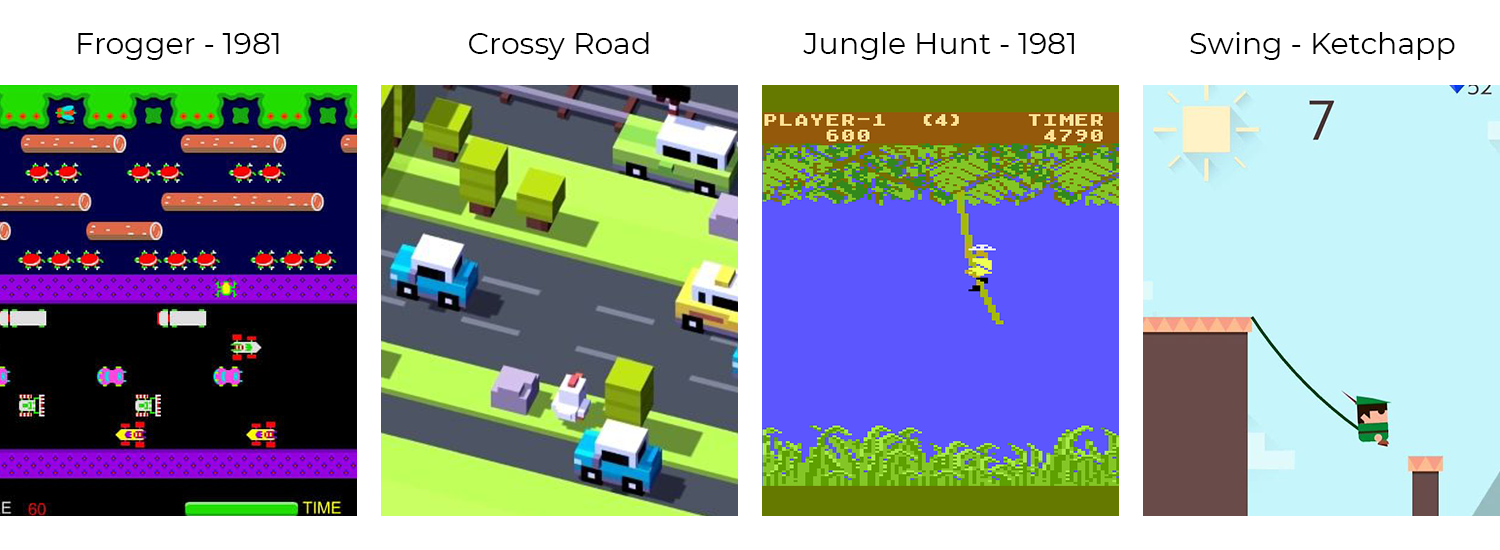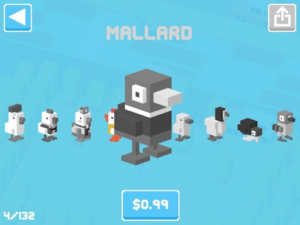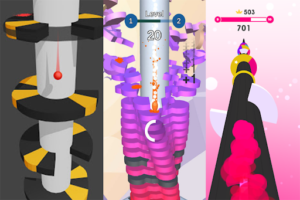
What is the most attractive thing in games? Perfect gameplay? Maybe an incredibly interesting story? Hyper-casual games do not have a story, they have little content, and yet it is one of the most addictive genres in the history of gaming. How is it even possible?
Voodoo, Ketchapp, Lion Studios, King. Have you ever seen their splash screens? Do you know Flappy Bird, Subway Surfers or Jetpack Joyride? Chances are you know at least one of them.
Hyper casuals dominated the mobile games market in 2017 and they are still growing in popularity. This Free2Play model generates more than 50% of the global gaming market revenue. Interested? Let’s take a closer look!
What are Hyper-Casual Games?
While preparing to write this article, I’ve talked to some people from the gaming industry and I came to this conclusion: hyper casuals are nothing more than arcades from the ’70s and ’80s with beautiful graphics and almost unlimited access.
Hyper-casual games are so addictive that you keep going back to them over and over again. Their beauty lies in the fact that you can play whenever and wherever you want. As the name suggests, hyper-casual games are derived from casual games, but they have simpler mechanics and instant gameplay. Usually, this is just “tap to play”.
I like to call them “waiting room games”, and that is exactly what they are.
We play these games in waiting rooms, on a bus, while queuing and during boring lectures at the university. They include short rounds and maximally simplified mechanics. You can play two minutes or six hours: you will learn the gameplay and mechanics instantly. In majority, they are one-touch or thumb slide games with a really simple user interface.

When and How the Genre Came to Life?
As I mentioned above, these games are nothing new.
Their beginnings reach to the early ’70s, but then they were called arcade games. The release of Flappy Bird (2013) is considered a breakthrough in the genre. That is when mobile games have begun to be (successfully) monetised. Later, we will talk about the business models. At that time, the market was overwhelmed with more complex games or total crap. It was the time when mid-core and hard-core games were en vogue. Simple 5-minute play games were practically inexistent. When such titles appeared, people immediately loved them.
“The ascendance of hyper-casual games can be credited to a number of things, from the way these games are able to fill an emerging gap in the gaming space, to advancements in ad monetization.” — ironsrc.com

Source: The rise of Hyper-casual & takeaways from Tap Tap Games, Game Camp
Why Have Hyper-Casual Games Achieved Such a Great Success?
If someone on the street asked me why the hyper casuals had achieved success, I would probably answer something like: “They are fun and simple, that’s why”.
That is a fair answer. But not fair enough.
Having put some thought into that, I’d say the only correct answer is that they are well-engineered. The fact that they are simple does not mean that just one person or two people work on them. Although they are usually developed by a small number of people for 1-3 months, this is only and exclusively the development phase, which in this case does not play a very important part. Successful hyper casuals are usually released by publishers who own whole teams of game designers responsible for analytics, preparing tables in Excel and calculating and managing such coefficients as retention (mainly D1 and D7), LTV (lifetime value) and CPI (cost per install). You can read more about analytics in mobile games in this article. Quite frequently, such publishers also have separate employees responsible for the ASO (App Store Optimisation). Together they form a powerful marketing machine that makes user acquisition a pure pleasure.
The fact that they are brilliantly thought-out means that they have a perfectly precise core loop. You can read about it in my previous article, which you will find here.
Hyper casuals represent a category that evolves slowly. It all started with simple flat 2D games. Then the creators went for 3D. From the very beginning, they were usually single-player games, but recently this trend has been changing, and from around 2018, hyper casuals are offered more and more often (mainly by Voodoo) as ”multiplayer” games.
Why ”multiplayer”, in quotation marks? I recently analysed Voodoo creations and concluded that they are in fact single-player games with very well-designed artificial intelligence.
Whence this statement? Press the home button on your phone and wait 2-3 seconds. Then return to the game. Everything is in the same place? Other players as well? Well, this is the obvious outcome. Other players are in fact bots that give us the illusion that the game is network-based. It is a very clever marketing gimmick considering that the main target of such games is usually young people who may not notice that they do not play with real people.
Primarily, such a game is supposed to be endless. This means that a player can spend tens of hours playing it and still have something to do: they can beat their own high score and compete with other players in ranked tournaments.
 Games representing this genre are often called “memeable” and “youtubable”. What does it mean? It often happens that the game is based on pop culture, social media or current events. A very good example is “Pen Pineapple Apple Pen” video, which became viral on YouTube (over 273 million views). Just a few days after its publication, Ketchapp (Ubisoft) made “Pineapple Pen” game (over 10 million downloads).
Games representing this genre are often called “memeable” and “youtubable”. What does it mean? It often happens that the game is based on pop culture, social media or current events. A very good example is “Pen Pineapple Apple Pen” video, which became viral on YouTube (over 273 million views). Just a few days after its publication, Ketchapp (Ubisoft) made “Pineapple Pen” game (over 10 million downloads).

Another great example is “Run Sausage Run” (over 50 million downloads). The game was created just a couple of days after the popular application Snapchat shared a filter with a smiling, dancing sausage.
Youtubability is extremely beneficial for every game. “Flappy Bird” has made such a great success because many well-known YouTubers recorded how they destroyed their mobile phones in rage while playing it.
Using the elements of pop culture and social media in games is a great marketing strategy, and I would recommend that to everyone.

Mechanics in Hyper Casuals
What kinds of mechanics attract the players? What makes them stay with the mobile game longer than a few minutes or come back to it after several days? In hyper-casual games, we can distinguish some specific mechanics.
Firstly, it always is a one-touch game. Why is that? Because it is difficult to play with both hands while standing on a bus.

The next core mechanic, which is present in all of those games, is a max 5 second tutorial. After downloading and installing an app, there is always a “tap to play” animated tutorial. Such a short tutorial means that those mechanics must be really simple and easy to learn.
 The tutorial itself is not even that important. A good example is “Helix Jump” from Voodoo. It is probably one of the most downloaded hyper casuals ever (over 550 million downloads out of over 2.1 billion downloads of Voodoo games), and yet its tutorial doesn’t even have any animation. Plain text only.
The tutorial itself is not even that important. A good example is “Helix Jump” from Voodoo. It is probably one of the most downloaded hyper casuals ever (over 550 million downloads out of over 2.1 billion downloads of Voodoo games), and yet its tutorial doesn’t even have any animation. Plain text only.
 Most of the hyper casuals are not reality-based. Your main character will probably be something like a sphere, a cylinder or a box. The whole world is rather unrealistic. Usually, it is composed of simple shapes.
Most of the hyper casuals are not reality-based. Your main character will probably be something like a sphere, a cylinder or a box. The whole world is rather unrealistic. Usually, it is composed of simple shapes.
 Another mechanic is the skins system. In almost every hyper-casual game, there is a store that allows you to change the character, its outfit and sometimes even the whole environment. It’s also a perfect place for the Ultimate Epic Legendary Gold Skin – today for only $0.99!
Another mechanic is the skins system. In almost every hyper-casual game, there is a store that allows you to change the character, its outfit and sometimes even the whole environment. It’s also a perfect place for the Ultimate Epic Legendary Gold Skin – today for only $0.99!
We give the player a chance to set their own goals, and the player will not get bored so fast because every once in a while they will get some new content. Thus, despite the monotony in the genre, the game becomes more diverse.
As it was said before, the genre is evolving. Currently, the main trends in game design include level and mechanic diversity. The research shows that endless runners are getting tired faster, which is why most of them are now being transformed into level-based games. In fact, these are exactly the same games as endless runners, only with added UI, but the player subconsciously gets the impression that they climb up the level ladder.
These two models are very often combined. At the start of the game, the player has a choice between endless mode and level mode. Enabling the player to choose is an interesting trick, especially in the case of games that have been released some time ago and are now being remastered.

Economy in Hyper Casuals
The economy in hyper-casual games is pretty specific. Very often, it is not as much planned and designed as in other genres. Probably due to the fact that these are small and short games. But that’s not the only reason
- Resources: these usually look the same as in other genres. There are scores, soft currencies, e.g. coins, and hard currencies, e.g. diamonds or emeralds. Sometimes it happens that the game operates only on such resources as life, a resource that technically does not exist. The game creates this illusory possession, but it does not implement the variable responsible for life, so the resource just changes the state of the game because the player can be either alive or dead.
- Sources: in hyper-casual games, the system is often source-based. There are very few resources, and they are usually generated by the system. In the case of the previously mentioned life resource, the only source is the system.
In terms of drains, converters and traders, there is nothing special about this genre. They basically look the same.
Deconstruction of internal economy. “Helix Jump” case study
The above-mentioned “Helix Jump” serves as a perfect example.
We can observe that in principle the player does not have any life bar, so they either live or not. Coins are a basic resource here. The source of this resource is level completion (actually, falling or crossing subsequent thresholds when falling) or watching ads. In turn, the coin trader is the store and its content (e.g. skins). There are no coin drains or converters in this game.
Monetisation in Hyper Casuals
This is definitely the best and the most interesting aspect of hyper-casual games.

Source: 2019 Predictions: #2 the Hyper-Casual Party, as We Know It, Will End, Abhimanyu Kumar
As we can see, it is worth taking a little interest in this genre if we think about conquering the mobile market. The demand grows YoY, and it does not look like it will stop.
But wait. It’s not as easy as it looks. If you think about entering the hyper-casual market, it will be extremely difficult for you. More than 50% of downloads in the hyper-casual category is split between three companies (SayGames – 18%, Voodoo – 17%, Good Job Games – 17%).

Source: 2019 Predictions: #2 the Hyper-Casual Party, as We Know It, Will End, Abhimanyu Kumar
 Additionally, new investors are still coming. Slowly, people from outside the mobile game industry and the gaming industry in general are starting to see the potential and invest huge amounts of money in mobile games.
Additionally, new investors are still coming. Slowly, people from outside the mobile game industry and the gaming industry in general are starting to see the potential and invest huge amounts of money in mobile games.
Source: The rise of Hyper-casual & takeaways from Tap Tap Games, Game Camp
First of all, we have to learn the difference between various types of ads. There are 3 basic types: banner, regular/interstitial ads and rewarded ads.
- Banner is a type of an advertisement which usually appears in the form of a small (5% of the screen) image that is displayed throughout the whole game time. It is usually located at the bottom of the screen.
- Regular/interstitial ad can be an image or a video which usually can be closed immediately or after 5 seconds. The profits are attributed for displaying the advertisement and for its viewing length.
- Rewarded ads are the greatest source of income. Such an ad can be several or even several dozen times more profitable than a regular ad. It is because the money for the advertisement is paid only for making the players download the game or complete some other in-game action. There is usually no compensation for watching only.
Once we establish this, we can clearly state that hyper casuals have such amazing gains mainly thanks to the rewarded ads.
In-app purchases are almost non-existing in this genre. They are generated only through “no advertising” option or epic skins mentioned above.
Since 2017, mobile markets have been dominated by hyper casuals and only few games from outside of this genre were able to enter top 20.

In red, we‘ve highlighted hyper-casual games. White colour represents all the other genres.
What makes this genre stand out is the fact that the usual monetisation mechanics from F2P games are not present here. There are no roulettes, loot boxes and in-app purchases. The whole revenue comes from ads.
How to Create a Successful Hyper Casual?
This is probably a big dream for many of us: make the second “Flappy Bird”.
Not exactly realistic. But maybe make $50k every day for a second “Flappy Bird”? Yeah, that’s better.
There are several ways to design a great and successful product.
 Pop-culture and social media inspiration: this is the easiest one. It is not very hard to find something hyped on YouTube, Twitter or Instagram. When we do, we have to just quickly make a game about it. We have a ready-made idea; we know more or less how the game assets will look like. The only thing we have to do is to add mechanics. Here is an example: the childhood game “The floor is lava”. In 2017, there was a lot of internet traffic due to the viral spread of videos portraying people playing it. That’s when Ketchapp made “The Floor Is Lava!” (over 5 million downloads).
Pop-culture and social media inspiration: this is the easiest one. It is not very hard to find something hyped on YouTube, Twitter or Instagram. When we do, we have to just quickly make a game about it. We have a ready-made idea; we know more or less how the game assets will look like. The only thing we have to do is to add mechanics. Here is an example: the childhood game “The floor is lava”. In 2017, there was a lot of internet traffic due to the viral spread of videos portraying people playing it. That’s when Ketchapp made “The Floor Is Lava!” (over 5 million downloads).
 Combining two mechanics: this is the semi-challenging one. We can take some old arcade and combine it with another game, change the camera perspective, change 2D models into 3D ones. There are a lot of possibilities. The sky is the limit.
Combining two mechanics: this is the semi-challenging one. We can take some old arcade and combine it with another game, change the camera perspective, change 2D models into 3D ones. There are a lot of possibilities. The sky is the limit.
 Setting your own trends: that’s the hard one. We must invent new mechanics. It is said that everything has already been invented, now we only combine it, improve it or redo it. It is true. But maybe there are some unfinished projects that can be followed up on. You can still come up with something ultra-good. Hole.io (over 184 million downloads) is a great example. I have never seen such mechanics before in any game. The creator probably got inspired by the real world (black hole, abyss). Maybe the game will encourage someone to come out of the basement and see what the real world looks like.
Setting your own trends: that’s the hard one. We must invent new mechanics. It is said that everything has already been invented, now we only combine it, improve it or redo it. It is true. But maybe there are some unfinished projects that can be followed up on. You can still come up with something ultra-good. Hole.io (over 184 million downloads) is a great example. I have never seen such mechanics before in any game. The creator probably got inspired by the real world (black hole, abyss). Maybe the game will encourage someone to come out of the basement and see what the real world looks like.
Summary
So, we are finally here. We know almost everything about the hyper-casual games, their origin and mechanics.
I can only wish you good luck in setting market trends.
Thank you for your time.
Sources:

